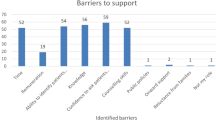Key Points
-
The largest study to date of the prevalence of advertising for foods and beverages potentially detrimental to dental health on UK television watched by children.
-
Awareness of the high proportion of advertisements that children are exposed to for items that are potentially detrimental to dental health should inform policy in this area.
-
Particular questions arising from these findings relate to how policymakers should handle foods that are classified as healthy from an obesity perspective but are detrimental to dental health.
Abstract
Objective To quantify the prevalence of advertising for foods and beverages potentially detrimental to dental health on UK television watched by children.
Design Content analysis of pre-recorded television advertisements (adverts).
Materials and methods Three hundred and fifty-two hours of television were recorded (one weekday and one weekend day, 6 am – 10 pm) from the main commercial channel (ITV1). All adverts were coded using pre-defined criteria.
Setting UK television recorded between January and December 2012.
Results Of 9,151 adverts, foods and beverages were the second most commonly advertised products (16.7%; n = 1,532). Nearly two-thirds of food adverts were for items that are potentially harmful to dental health (61%; n = 934). Of these, 96.6% were cariogenic and 11% were acidogenic foods. During peak children's viewing hours, the proportion of foods that are potentially harmful to dental health was significantly higher than for non-harmful foods (65.9% vs. 34.1%; p = 0.011). Adverts for foods potentially harmful to dental health were rare around children's programmes, but significantly more frequent during other programmes watched by children (p <0.001).
Conclusion UK children are exposed to a particularly high proportion of advertisements for foods that are potentially detrimental to their dental health during their peak viewing hours and around the programmes they watch the most.
Similar content being viewed by others
Log in or create a free account to read this content
Gain free access to this article, as well as selected content from this journal and more on nature.com
or
References
Cairns G, Angus K, Hastings G . The extent, nature and effects of food promotion to children: A review of the evidence to December 2008. Prepared for the World Health Organization. Institute for Social Marketing, University of Stirling & the Open University. Geneva, Switzerland: WHO Press, 2009.
Institute of Medicine. Food marketing to children and youth: threat or opportunity? Washington DC: The National Academies Press, 2006.
Kunkel D, Wilcox B L, Cantor J, Palmer E, Linn S, Dowrick P . Report of the APA task force on advertising and children. 2004.
Boyland E J, Nolan S, Kelly B et al. Advertising as a cue to consume: a systematic review and meta-analysis of the effects of acute exposure to unhealthy food and nonalcoholic beverage advertising on intake in children and adults. Am J Clin Nutr 2016; 103: 519–533.
Boyland E J, Harrold J A, Kirkham T C, Halford J C G . The extent of food advertising to children on UK television in 2008. Int J Pediatr Obes 2011; 6: 455–461.
Rodd H D, Patel V . Content analysis of children's television advertising in relation to dental health. Br Dent J 2005; 199: 710–713.
Ghimire N, Rao A . Comparative evaluation of the influence of television advertisements on children and caries prevalence. Glob Health Action 2013; 6: 20066.
Morgan M, Fairchild R, Phillips A, Stewart K, Hunter L . A content analysis of children's television advertising: focus on food and oral health. Public Health Nutr 2009; 12: 748–755.
Locker D . Deprivation and oral health: a review. Community Dent Oral Epidemiol 2000; 28: 161–169.
The Health and Social Care Information Centre. The Children's Dental Health (CDH) Survey 2013, England, Wales and Northern Ireland. Available at: http://content.digital.nhs.uk/catalogue/PUB17137 (accessed January 2017).
Pitts N, Harker R . Obvious decay experience: Children's Dental Health in the United Kingdom 2003. London: Office for National Statistics, 2005.
Bagramian R A, Garcia-Godoy F, Volpe A R . The global increase in dental caries. A pending public health crisis. Am J Dent 2009; 22: 3–8.
Duggal M S, van Loveren C . Dental considerations for dietary counselling. Int Dent J 2001; 51: 408–412.
Moynihan P J . Dietary advice in dental practice. Br Dent J 2002; 193: 563–568.
Public Health England. SACN Carbohydrates and Health. 2015. Available at https://www.gov.uk/government/uploads/system/uploads/attachment_data/file/445503/SACN_Carbohydrates_and_Health.pdf (accessed January 2017).
Public Health England. The Eatwell Guide: Helping you eat a healthy, balanced diet. 2016. Available at: https://www.gov.uk/government/uploads/system/uploads/attachment_data/file/551502/Eatwell_Guide_booklet.pdf (accessed January 2017).
Anderson C A, Curzon M E, Van Loveren C, Tatsi C, Duggal M S . Sucrose and dental caries: a review of the evidence. Obes Rev 2009; 10 Suppl 1: 41–54.
Tickle M, Blinkhorn A S, Milsom K M . The occurrence of dental pain and extractions over a 3year period in a cohort of children aged 3–6 years. J Public Health Dent 2008; 68: 63–69.
Kanaffa-Kilijanska U, Kaczmarek U, Kilijanska B, Frydecka D . Oral health condition and hygiene habits among adult patients with respect to their level of dental anxiety. Oral Health Prev Dent 2014; 12: 233–239.
Casamassimo P S, Thikkurissy S, Edelstein B L, Maiorini E . Beyond the dmft: the human and economic cost of early childhood caries. J Am Dent Assoc 2009; 140: 650–657.
Ofcom. Television advertising of food and drink products to children: Final statement. 22 February 2007. Available at: http://stakeholders.ofcom.org.uk/consultations/foodads_new/statement 2007 (accessed January 2017).
Ofcom. Changes in the nature and balance of television food advertising to children: A review of HFSS advertising restrictions. 17 December 2008. Available at: https://www.ofcom.org.uk/__data/assets/pdf_file/0028/23977/hfssdec08.pdf (accessed January 2017).
Adams J, Tyrrell R, Adamson A J, White M . Effect of restrictions on television food advertising to children on exposure to advertisements for 'less healthy' foods: Repeat cross-sectional study. PLoS One 2012; 7: e31578.
Ofcom. The communications market 2015: Television and audio-visual. 2015. Available at: https://www.ofcom.org.uk/__data/assets/pdf_file/0024/13974/uk_2.pdf (accessed January 2017).
Broadcasters Audience Research Bureau. Available from: http://www.barb.co.uk/whats-new/weeklytop30.
Ofcom. Children and parents: Media use and attitudes report 2012. 5 February 2015. Available at: https://www.ofcom.org.uk/research-and-data/media-literacy-research/children/october-2012 (accessed January 2017).
Ofcom (2012). Children's TV viewing: BARB analysis.
Kelly B, Halford J C G, Boyland E J et al. Television food advertising to children: a global perspective. Am J Public Health 2010; 100: 1730–1736.
Gantz W, Schwartz N, Angelini J R, Rideout V . Food for thought: Television food advertising to children in the United States: The Kaiser Family Foundation, 2007.
Ofcom. Childhood obesity: Food advertising in context. https://www.ofcom.org.uk/research-and-data/tv-radio-and-on-demand/tv-research/food-ads (accessed January 2017).
Department of Health. Guide to creating a front of pack (FoP) nutritional label for pre-packed products sold through retail outlets. 2013. Available at https://www.gov.uk/government/uploads/system/uploads/attachment_data/file/566251/FoP_Nutrition_labelling_UK_guidance.pdf (accessed January 2017).
Hieke S, Wilczynski P . Colour Me In-an empirical study on consumer responses to the traffic light signposting system in nutrition labelling. Public Health Nutr 2012; 15: 773–782.
Nizel E, Papas S . Nutrition in clinical dentistry. 3rd ed. Philadelphia: WB Saunders Company, 1989.
Advertising Standards Authority. Compliance report: Food and soft drink advertising survey 2011.
Acknowledgements
This study formed part of Mrs Muneera Al-Mazyad's DDSc dissertation at the University of Liverpool, Orthodontic Department, who hereby acknowledge the support of the Ministry of Health in Kuwait.
Author information
Authors and Affiliations
Corresponding author
Additional information
Refereed Paper
Rights and permissions
About this article
Cite this article
Al-Mazyad, M., Flannigan, N., Burnside, G. et al. Food advertisements on UK television popular with children: a content analysis in relation to dental health. Br Dent J 222, 171–176 (2017). https://doi.org/10.1038/sj.bdj.2017.120
Accepted:
Published:
Issue date:
DOI: https://doi.org/10.1038/sj.bdj.2017.120
This article is cited by
-
Impact of soft drinks to health and economy: a critical review
European Archives of Paediatric Dentistry (2020)
-
A content analysis of Australian television advertising: focus on child and adolescent oral health
BMC Pediatrics (2018)
-
Child dental health: Bombarded children
British Dental Journal (2017)
-
Are children's eyes bigger than their stomachs?
British Dental Journal (2017)



